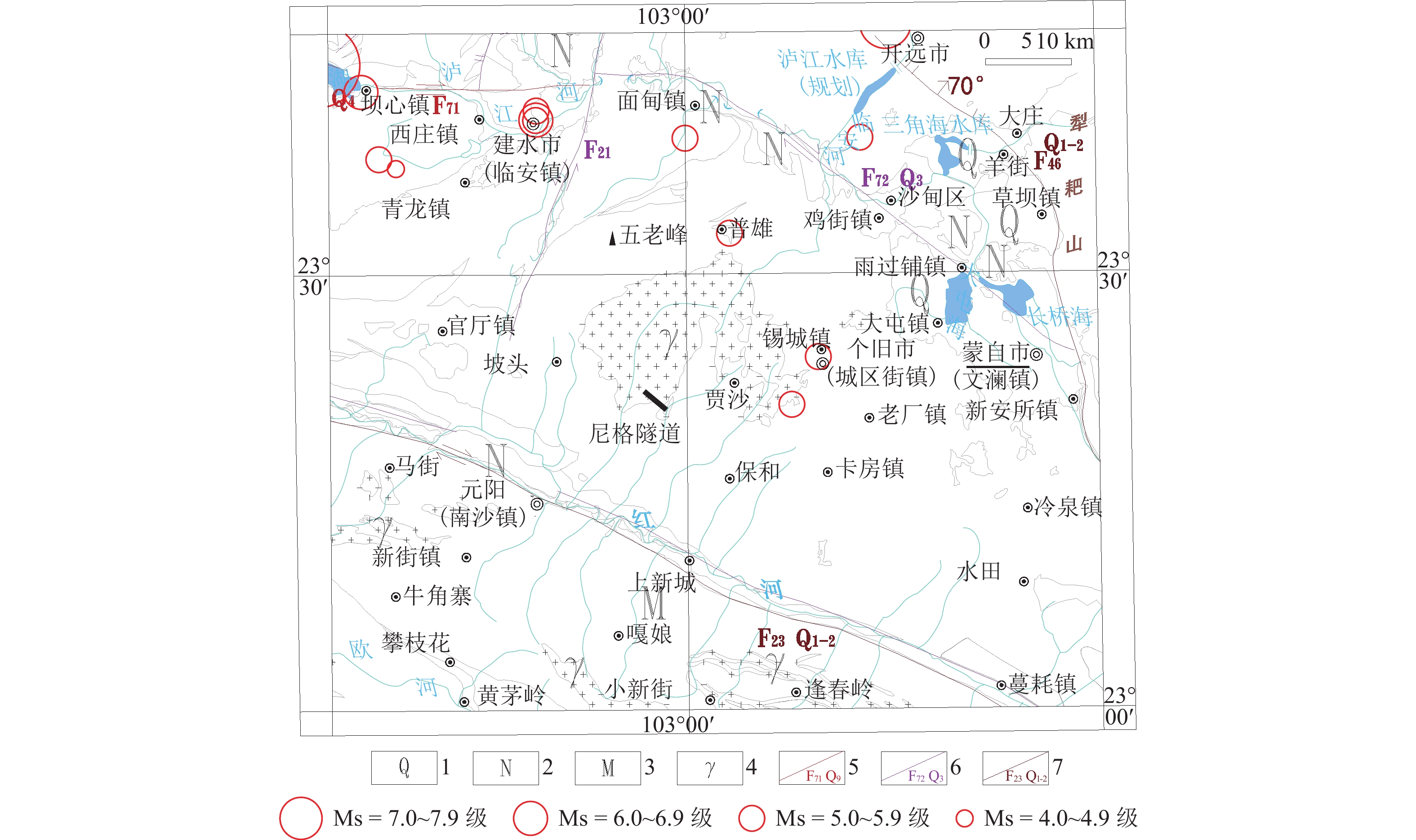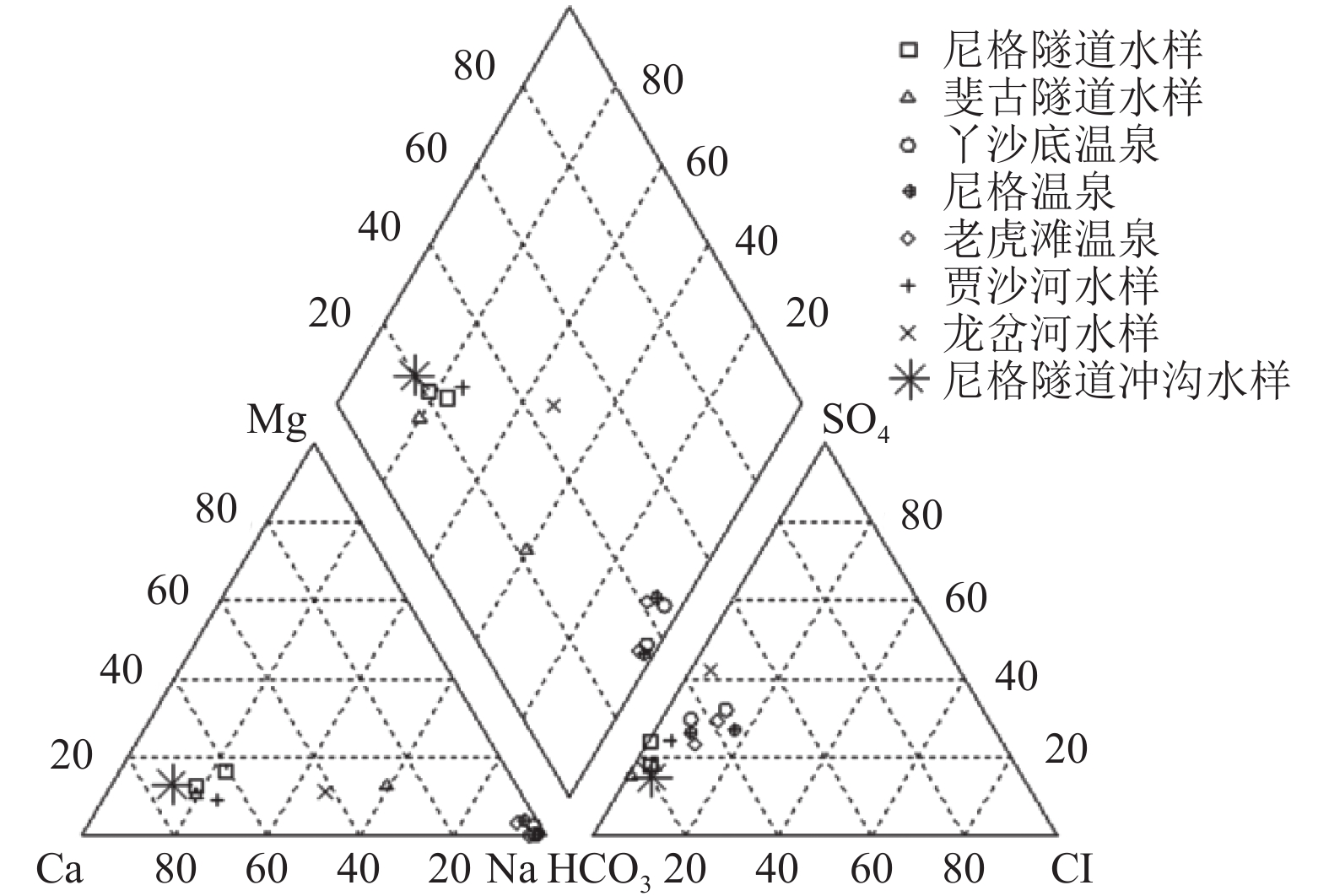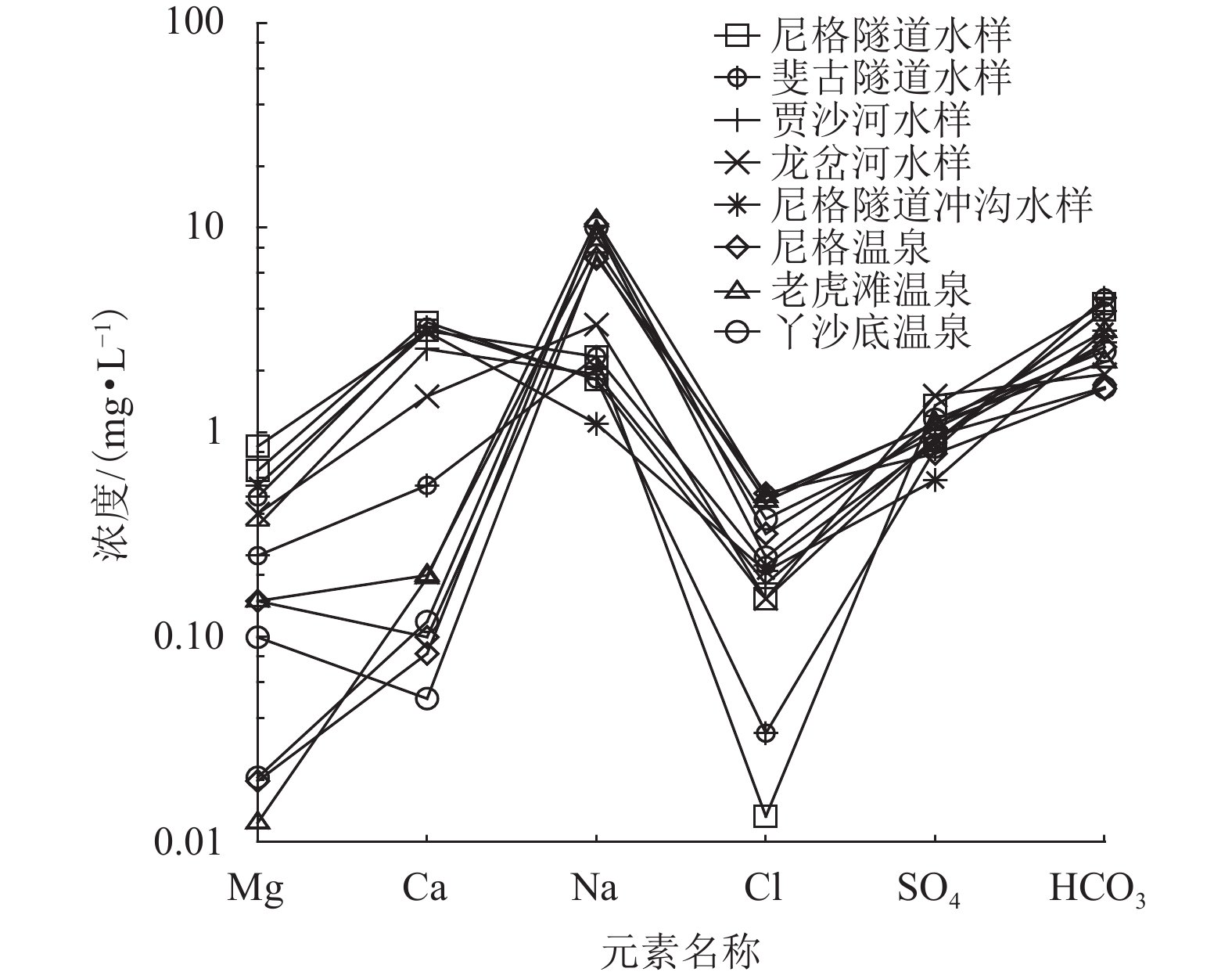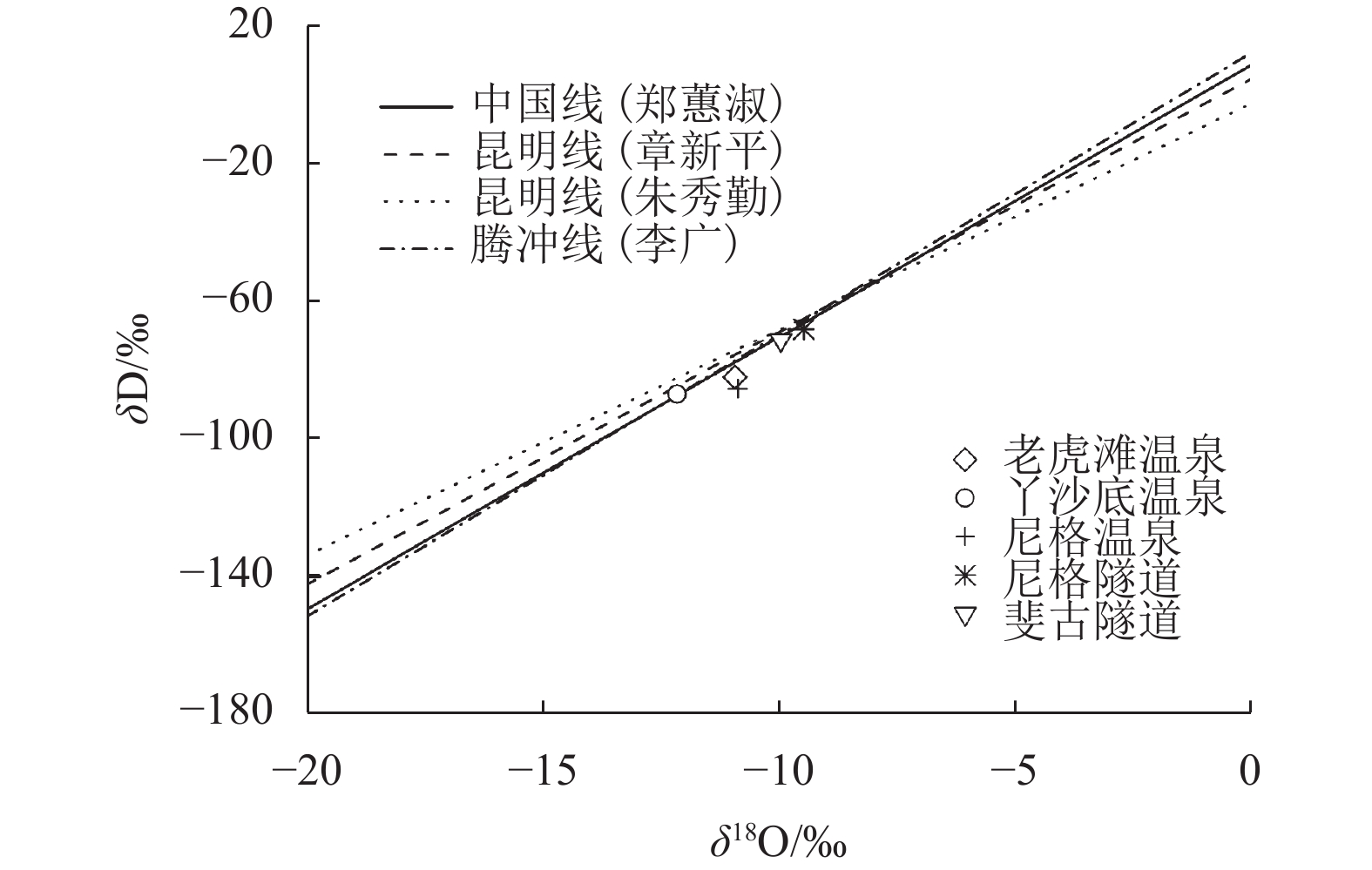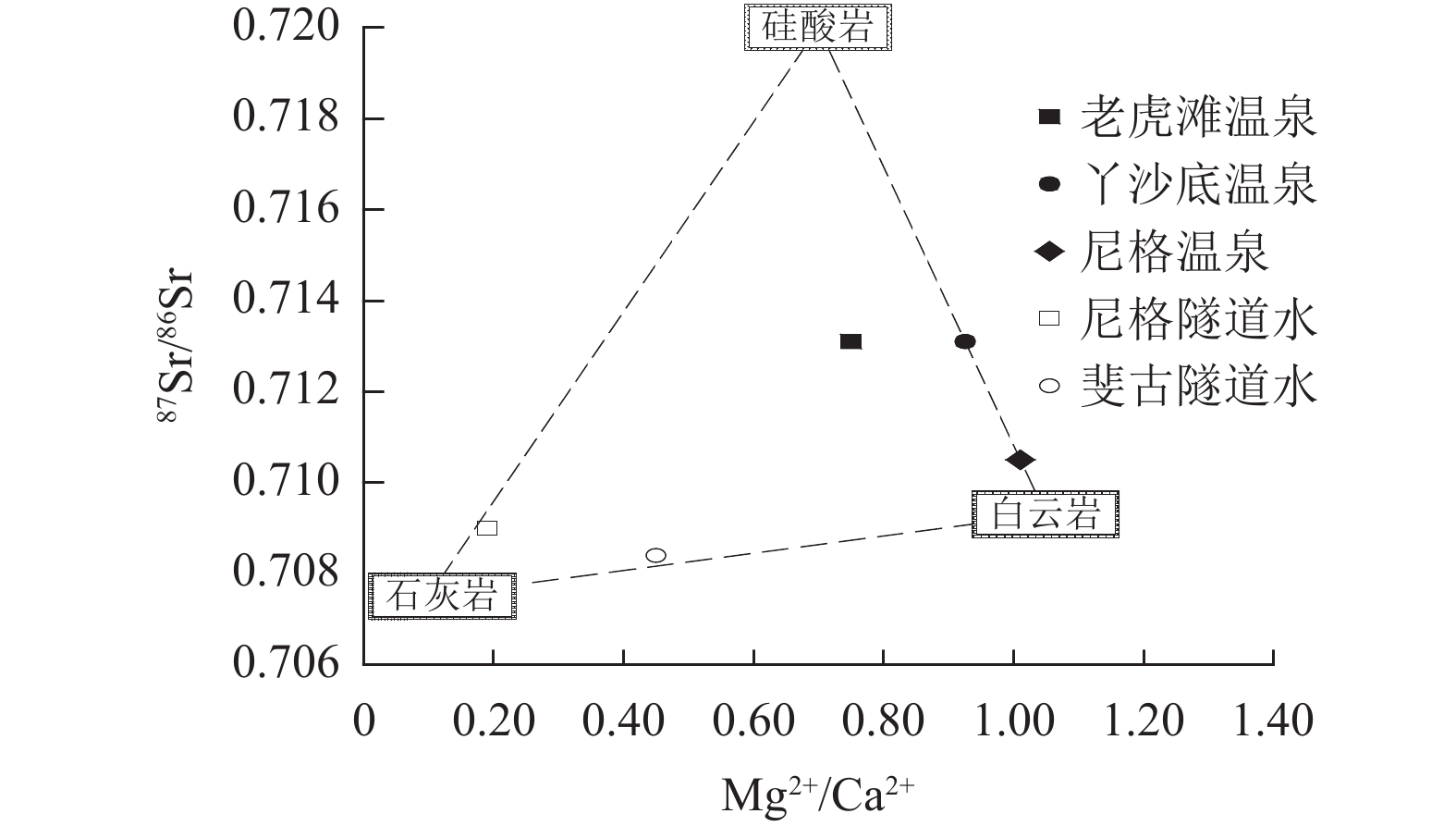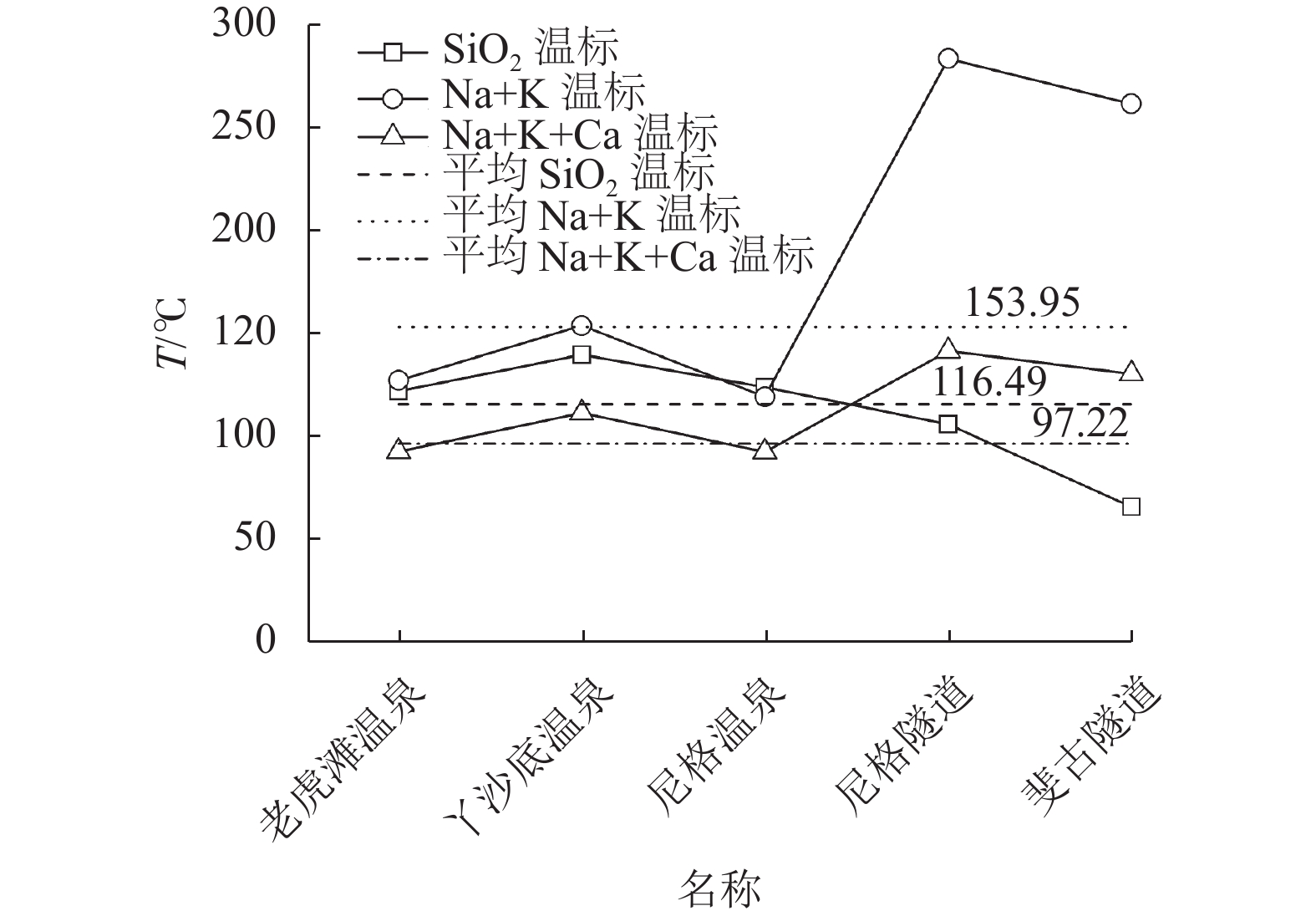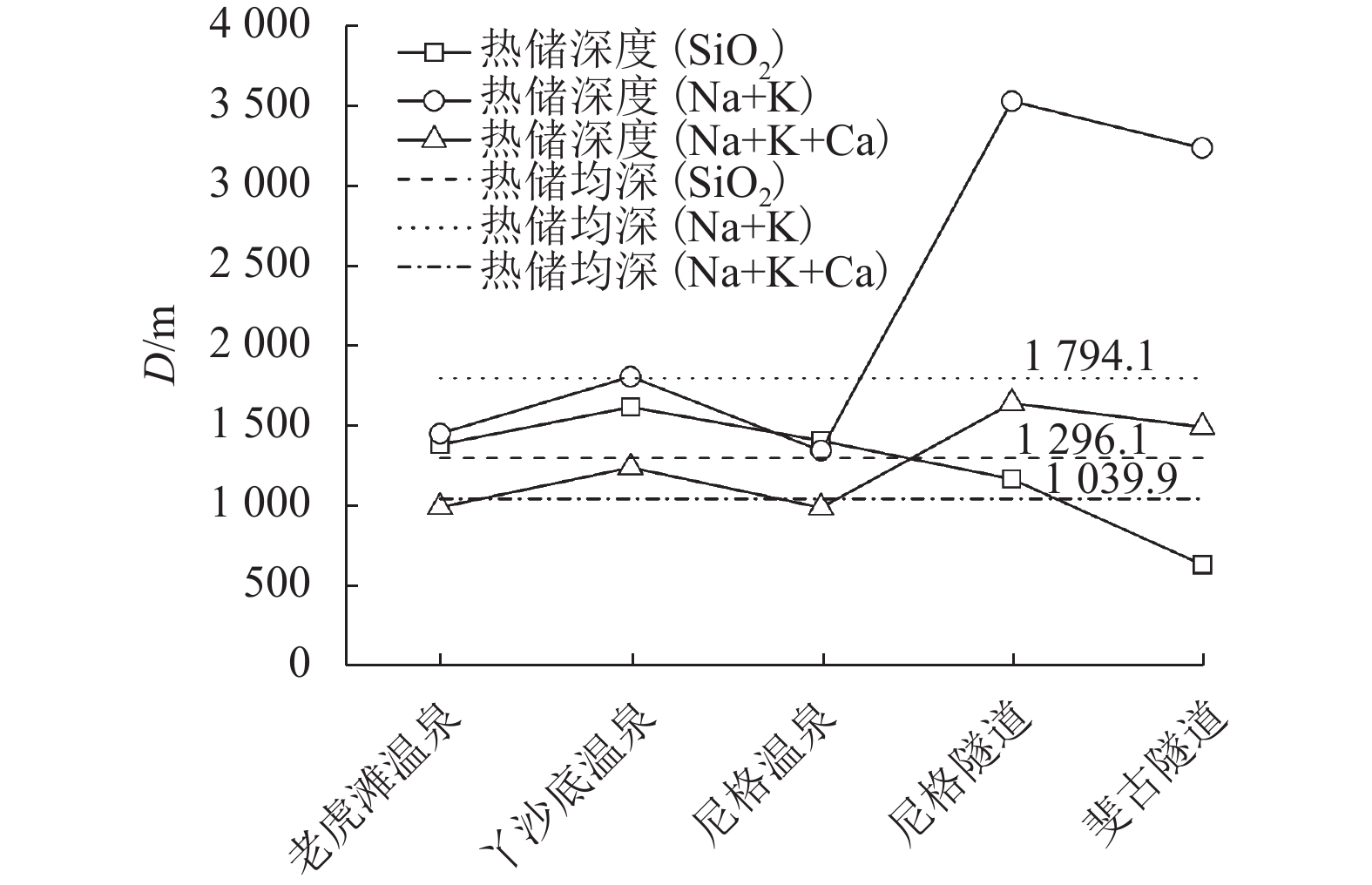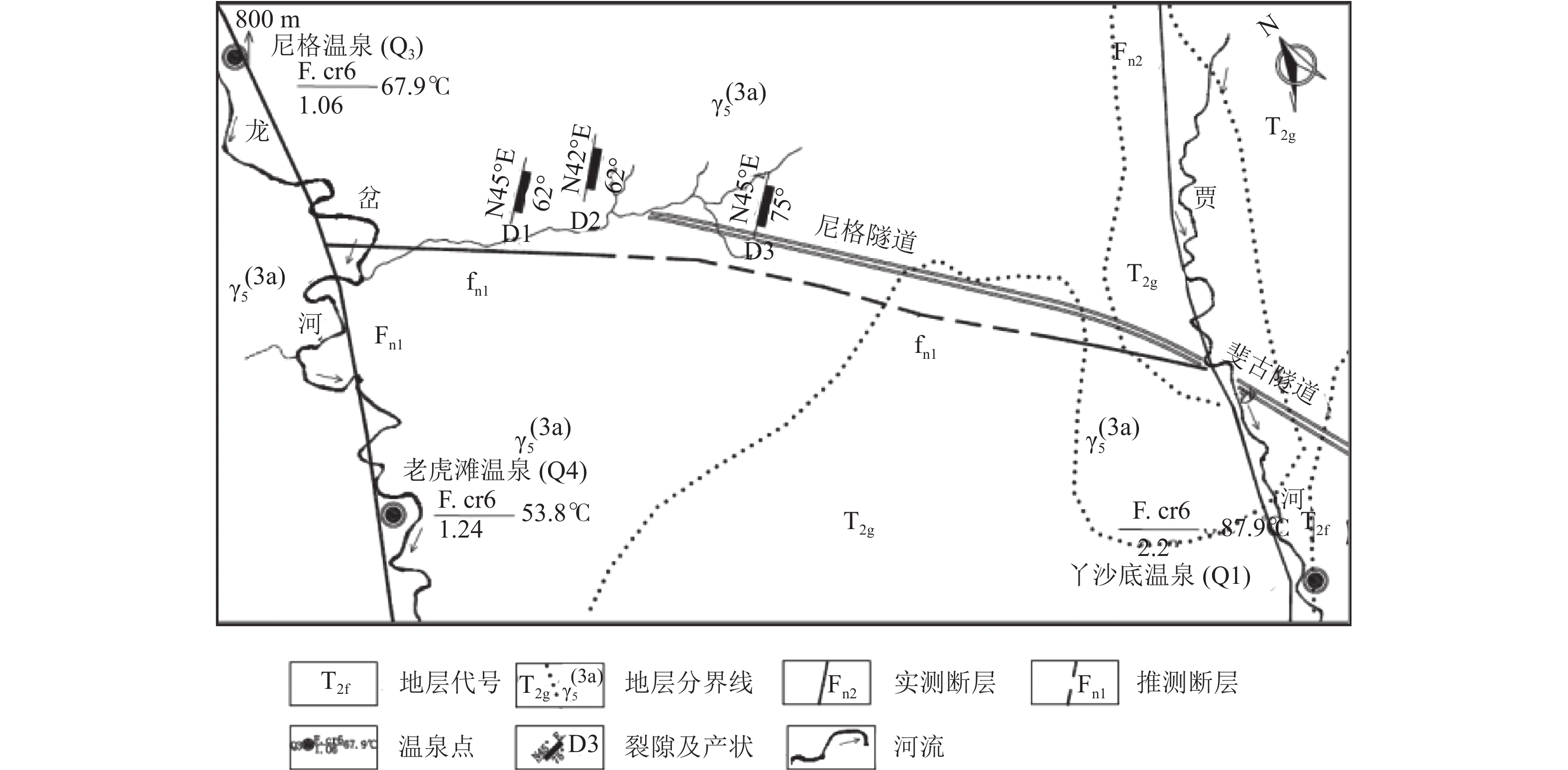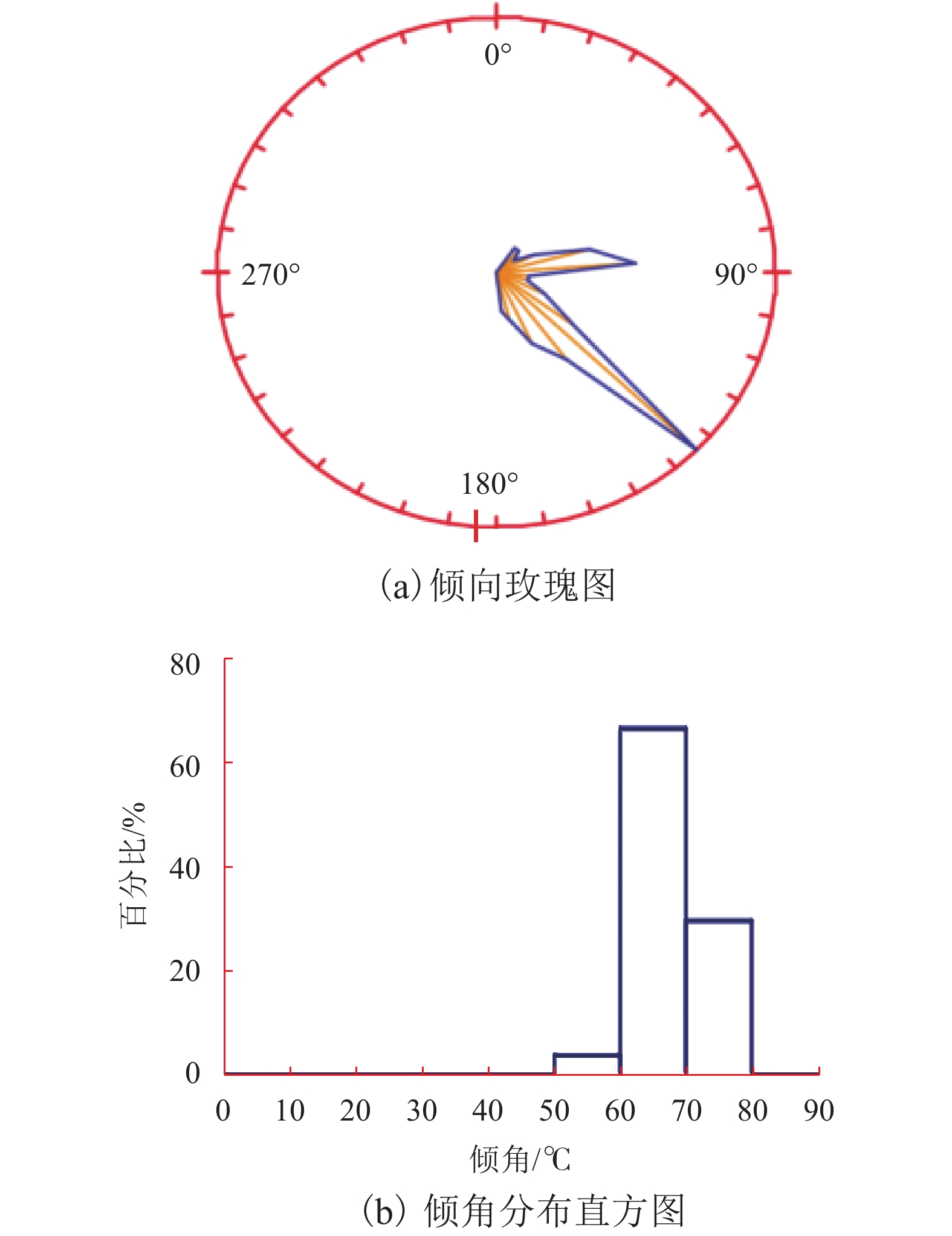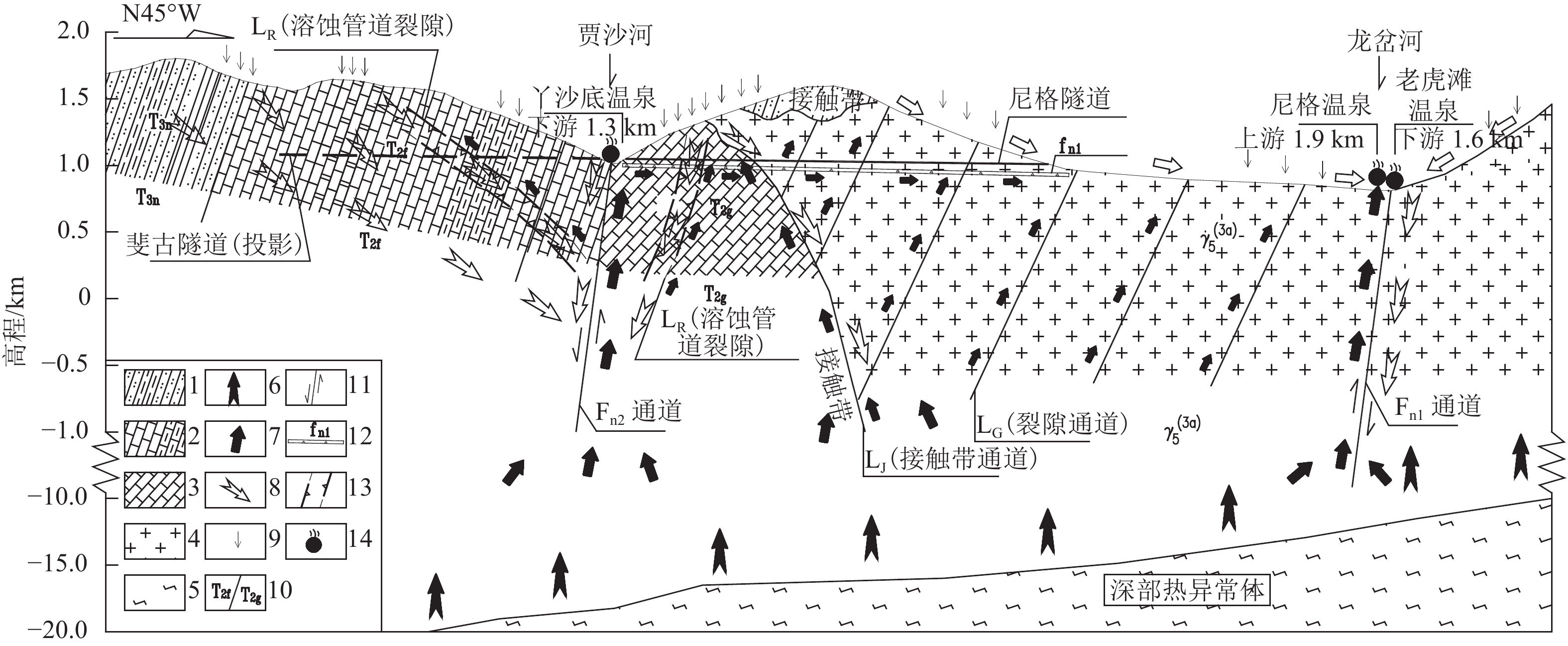Geological Genesis of Tunnel High Ground Temperature
-
摘要:
为研究隧道高地温的地质成因,以云南某在建高速公路隧道——尼格隧道为研究对象,该隧道兼有高水温与高岩温,最高水温达63.4 ℃,最高岩温达88.8 ℃. 从区域地质构造及地震特征、水化学特征、地热储特征等对区域性的热因控制、水源、热源、导热通道等进行了分析,利用氢氧同位素分析法、锶同位素分析法、微量元素分析法、放射性元素分析法等对隧址区的热水来源及演变过程、热源成因进行了研究,并结合隧道工程地质、水文地质条件及开挖揭示状况,对隧道高水温段及高岩温段的地质成因过程进行了剖析. 研究结果表明:灰岩段高水温的成因过程与花岗岩段高岩温有所差异,隧道高水温的成因过程为热源(深部热异常体)—主要传热通道(深循环)—次级传热通道—浅表水体混合、水岩作用,其过程伴随着冷热水混合作用、离子交换作用等;隧道高岩温的成因过程为热源(深部热异常体、放射性元素衰变生热)—主要传热通道(深循环)—次级传热通道—热气沿裂隙传至隧道岩体,其过程伴随着S元素的富集,易形成H2S或SO2有毒有害气囊.
Abstract:A highway tunnel under construction in Honghe Prefecture, Yunnan Province was taken as the research object to study the geological genesis of high ground temperature. The tunnel has both high water temperature and high rock temperature, with the maximum water temperature of 63.4 ℃ and the maximum rock temperature of 88.8 ℃. The regional thermal control, water source, heat source, and heat conduction channel are analyzed from the aspects of regional geological structure, seismic characteristics, hydrochemical characteristics, and geothermal reservoir characteristics. The hot water source, evolution process, and origin of heat source are studied by means of hydrogen oxygen isotope analysis, strontium isotope analysis, trace element analysis, and radioactive element analysis. Based on the geological, hydrogeological and excavation conditions of the tunnel, the geological genesis of the high water temperature section and the high rock temperature section of the tunnel is dissected and discussed. The results show that the genetic process of high water temperature in limestone sections is different from that in granite sections. The genetic process of high water temperature in tunnel is “heat source (deep thermal anomaly)–main heat transfer channel (deep cycle)–secondary heat transfer channel–shallow water mixing and water rock interaction”, which is accompanied by cold and hot water mixing, ion exchange, etc.; while the genetic process of high rock temperature in tunnel is “heat source (deep abnormal body, radioactive element decay heat generation)–main heat transfer channel (deep cycle)–secondary heat transfer channel–hot gas being transmitted to the tunnel rock mass along the crack”, and the process is accompanied by the enrichment of S element, which is favorable to the formation of toxic and harmful air bag of H2S or SO2.
-
我国西南地区地形地貌多变、地质条件复杂、地热资源丰富[1-3],在交通、水利水电等工程建设过程中往往涉及大量隧道工程,高地温问题已经成为隧道建设的难点问题之一[4]. 当高地温隧道施工作业时洞内空气温度超过28 ℃ 时,可视为高地温隧道. 与常温隧道相比,高地温隧道的投资成本、前期勘测及选线、隧道设计、施工措施、后期运营等都存在较大不同[5-8].
隧道高地温的地质成因研究是隧道设计、施工的基础和前提,目前关于区域性的地热状况、温泉成因等研究较多,但针对高地温隧道地质成因方面的研究尚为少见. 袁伟等[9]通过对泉域地质构造、水文地质条件的分析,根据温泉的水文地球化学特征,从温泉的水源、热源、构造等方面阐明了海螺沟温泉的成因. 周春景等[10]在整理、分析云南大理至瑞丽拟建铁路沿线及其邻区现今地温场分布特征的基础上,综合研究、探讨了该区地温场与岩浆活动、活动构造、地震活动、区域深部构造的关系.
1. 项目概况
本文以云南建水(个旧)至元阳高速公路工程在建尼格隧道为研究对象,该隧道全长3.3 km,最大埋深640 m,采用进、出口双向双洞施工(如图1). 隧道穿越三叠系中统个旧组(T2g)灰岩和燕山期侵入花岗岩(γ53(a)). 灰岩段主要表现为高水温,最高水温63.4 ℃,涌水量一般3 ~ 9 L/s,花岗段主要表现为高岩温,最高温度达88.8 ℃[11],该隧道目前为我国最高地温公路隧道,工程案例颇为典型.
本文从隧道高地温形成的热源、导热通道及成因过程3个方面展开研究. 从分析研究区的水化学特征、地热储特征、岩石生热特征等确定高地温的热源主要为地壳深部热异常体,岩石放射性生热为花岗岩段高岩温的热源附加;从分析研究地质构造特征确定了隧道高地温的导热主通道和次通道;从分析研究区的氢氧同位素、锶同位素、微量元素等特征,研究了隧道高地温形成过程的热水来源、演变过程、水岩作用、离子交换等特征,并分别对隧道高水温及高岩温的成因过程进行了剖析.
2. 区域地质构造及地震特征分析
研究区位于北西向红河断裂以北东的褶皱区,地处三江造山系向扬子地台的过渡地带,所属大地构造单元为华南褶皱带(一级)、滇东南褶皱带(二级). 区域地震构造如图2所示. 图中:Ms为震级. 隧址所在地位于北西向的红河断裂(F22)、北西西向的漾田—鸡街—蒙自断裂(F72)、北北西向的东山断裂(F46)、北北东向的东山寨—唐家庄断裂(F21)组成的地块中,近代构造活动强烈,地质构造极为复杂. 根据中国估算热流值分布图[12],研究区热流值为50~60 mW/m2.
区域性活动断裂构造往往形成地下热通道,热储体(上地幔热异常源、新近岩浆活动余热源、放射性元素衰变散热源)易通过活动性断裂带向上传导至地表或与浅表冷水做深循环,形成中高—高温热泉. 隧址距红河断裂最近处约18 km,并由次级断裂龙岔河断裂(北北东向)、贾沙河断裂(北北东向)接入隧址区,形成研究区高地温的热传导通道,隧道研究区周边5 km范围内分布3个温泉,温泉水温53.8 ~87.9 ℃,属中高—高温热泉.
研究区宏观上位于鲜水河—滇东地震带的南部,处于南北向的小江地震带与北西向的红河断裂地震带交汇处[12],呈现明显的“X”形展布,地震能势(5 ~ 7) × 1016 J/a[12-13].
强烈地震孕育的部位−般存在特殊的热-震能态结构,Ms>6.0级的地震震中往往位于高温地热场附近的“冷块”区,隧道研究区周边(小于30 km)曾发生过7 ~ 9级地震3次,对研究区高地温形成具有重要的指示作用.
3. 水化学特征及地热储特征分析
3.1 水化学特征分析
将隧道出水、温泉水及周边水体的水质检测成果整理得Piper三线图及Schoeller指印图(见图3、图4). 由图可以看出:尼格隧道、斐古隧道水体化学类型为HCO3—Ca型,pH值为7.71 ~ 9.25,属弱碱性—碱性水,矿化度<1 g/L,属淡水;周边3个温泉水体化学类型为HCO3•Cl—Na型,pH值为7.00 ~ 9.45,属弱碱性水,矿化度<1 g/L,属淡水;地表水体化学类型为HCO3—Ca型,pH值为7.95 ~ 8.54,属弱碱性水,矿化度<1 g/L,属淡水. 由此分析,隧道出水、周边温泉水、地表水均为重碳酸型水体,地下深循环热水水源主要是来自大陆环境的大气降水、浅表水入渗汇合而成,温泉水体中的氯盐表明水体具有一定的深成形成环境,深成环境中的热水在上升过程中与大陆环境的浅表混合作用和与可溶岩的水岩作用致使隧道水体中的Ca离子质量分数较高.
将隧道出水及温泉水体的氢氧同位素及锶同位素检测成果整理如表1,表中:两元素相比表示两元素质量分数比值. 结合大气水线[14](中国线、昆明线、腾冲线),得到氢氧同位素与大气水线相关图(见图5). 从表1、图5可以看出:尼格隧道、斐古隧道出水、3个温泉水地下水δD和δ18O值均位于大气水线(中国线、昆明线、腾冲线)附近,可以判定地下水的来源主要为大气降水和浅表水入渗;5组水样点均落在大气水线下方,发生了“18O漂移”现象,表明在循环过程中与岩石介质发生较为强烈的溶滤作用,导致水中的轻氧同位素与岩石中的重氧同位素发生水—岩交换作用,使得水体中的δ18O偏高;隧道热水体相比温泉水而言,δD和δ18O值均较高,且δD值差异更明显,可能的原因有:温泉水中的深成水体形成时的气候比现今寒冷,深成古水体中δD和δ18O原有值较低,上升过程保留了原有的特征;氢同位素比氧同位素的分馏速率大,经过多次蒸发分馏作用使得降水中的δD相对偏重,而隧道水体中天然降水所占比例比温泉水大,使其δD值更高.
表 1 氢氧同位素及锶同位素检测成果Table 1. Detection results of hydrogen oxygen isotopes and strontium isotopes名称 位置 地层 高程/m 流量/
(L•s−1)温度/℃ δD/‰ δ18O/‰ w(Sr)/
(mg•L−1)87Sr/86Sr Mg2 +/Ca2 + 老虎滩温泉 龙岔河 γ53(a) 花岗岩 762 1.24 53.8 −82.30 −10.91 0.1909 0.7131 0.750 0 丫沙底温泉 贾沙河 T2g 灰岩 940 8.20 87.9 −87.24 −12.13 0.2666 0.7105 1.990 0 尼格温泉 龙岔河 γ53(a) 花岗岩 908 3.06 67.9 −85.59 −10.85 0.1096 0.7131 1.500 0 尼格隧道出水 T2g 灰岩 3.00 ~ 9.00 64.0
(最高)−68.23 −9.45 0.3468 0.7090 0.190 0 斐古隧道出水 T2g 灰岩 0.50 ~ 3.00 46.0
(最高)−71.41 −9.94 1.1487 0.7084 0.450 0 锶同位素不会随矿物岩石等沉积物形成的作用发生变化,蒸发、生物同化、相态分离等作用不会对其组成产生影响,因此锶元素的浓度变化及锶同位素可以作为研究物质迁移和变化过程中重要的示踪剂[15]. 研究区5组水样的Sr元素质量分数在0.1096 ~ 1.148 7 mg/L,平均值0.412 5 mg/L,87Sr/86Sr质量分数比值在0.708 4 ~ 0.713 1,平均值0.710 8,该区地下水的锶元素组分主要来源于石灰岩和花岗岩,按Pu等[16]的研究成果,不同矿物中的锶同位素组成明显不同,可将87Sr/86Sr质量分数平均比值0.707 5和低Mg2 + /Ca2 + 质量分数比值(约0.100 0)作为石灰岩溶解物质的端员;87Sr/86Sr质量分数比值0.709 3和较高Mg2 + /Ca2 + 质量分数比值(约1.050 0)作为白云岩溶解物质的端员;87Sr/86Sr质量分数比值0.720 0和中等Mg2 + /Ca2 + 质量分数比值(约0.700 0)作为硅酸盐岩溶解物质的端员,如图6所示. 可看出,尼格隧道水、斐古隧道水体落于石灰岩端员附近,地下水主要来源于石灰岩风化溶解;3个温泉水落于白云岩与硅酸盐岩之间,反映出地下水在沿红河断裂、龙岔河断裂、贾沙河断裂等做深循环过程中与燕山期侵入花岗岩、表层白云岩的水岩相互作用.
3.2 地热储特征分析
运用SiO2、Na + K、Na + K + Ca等地热温标可推算场地深部热储体的温度[17-18],由于热矿水在上升过程中与浅表水体混合,SiO2质量分数已被稀释,SiO2法得到的热储温度和热储埋深为低值,Na + K法得到的热储温度和热储埋深往往为高值. 根据已有温标法研究成果[18],计算研究区热储温度(T)及其埋藏深度(D),计算如式(1)、(2).
T={13095.19−lgcSiO2−273.15,SiO2温标法,1217lg(cNa/cK)+1.438−273.15,Na+K温标法,1647lg(cNa/cK)+β[lg(√cCa/cNa)+2.06]+2.47−273.15,Na+K+Ca温标法, (1) D=(T−T0)K/Q, (2) 式(1)、(2)中:c为离子含量,对应下标为各元素的离子含量;T < 100.00 ℃,
β=43 ;T > 100.00 ℃,β=13; T0为当地年平均气温(根据当地气象资料,取19 ℃);K为热导率(取2.30 W/(m•k));Q为热流密度(取0.173 W/m2).根据隧址周边3个温泉及尼格隧道热水、邻近斐古隧道热水的水质检测资料[11],计算得到研究区热储温度和热储埋深如图7、8所示.
从图7、8可以看出:SiO2温标法所得T=116.49 ℃,平均热储埋深D=1296.1 m;Na + K温标法所得T=153.95 ℃,D=1 794.1 m;Na + K + Ca温标法所得T=97.22 ℃,D=1 039.9 m,3个温泉水体SiO2温标热储温度值与Na + K温标热储温度值较为接近,均高于Na + K + Ca温标热储温度值,可能的原因为SiO2含量在上升过程中与浅表水的混合稀释程度相近,且在燕山期侵入作用(γ5(3a))过程中有一定的SiO2补给源;与3个温泉水体相比,位于沉积岩中的2个隧道水体的热储温度与热储埋藏深度的Na + K温标值明显高于SiO2温标值和Na + K + Ca温标值,SiO2温标值最低,说明隧道水体的大陆环境及水(可溶岩)作用更突出.
4. 热源及导热通道分析
4.1 热源分析
根据相关研究成果[8],地热的来源主要有4种:1) 地幔软流圈局部上穹形成热点,即地壳深部热异常体;2) 地下岩浆房或地壳内高温侵入体或地表喷出体冷却过程中散热,即岩浆岩余热;3) 地壳内断裂活动产生的摩擦热,往往呈辅助伴生作用;4) 岩石(花岗岩)自身的放射性元素衰变生热.
根据区域地质特征、水化学特征、地热储特征等分析,隧址区的热源具有一定深成环境特征,认为地壳深部热异常体为隧道高地温的主要热源.
个旧地区的酸性岩浆岩(花岗岩)分布众多温泉,尼格隧道周边温泉一般53.00 ℃~ 89.00 ℃. 个旧花岗岩为燕山期(γ53(a))侵入作用形成,根据研究资料[19],在岩浆岩侵入到2.5 ~ 10.0 km深度,侵入时的温度为1 200.00 ℃,固结时为900.00 ℃,则5 km厚的岩浆岩完全固结时要75万年,冷却到300.00 ℃需要数百万年,因此只有上新世的侵入体才可能将其热量保持到现在,个旧的燕山期花岗岩不可能由岩浆余热产生热源.
酸性岩浆岩中放射性元素衰变可能产生一定的热流,个旧花岗岩体富含稀土放射性矿物,在铅矿岩中,出现微量的晶质铀岩. 说明侵入岩体中有较丰富的放射性元素存在,蜕变释热的热能可成为地下水增温的热源之一.
岩石放射性生热率反映单位体积的岩石在单位时间内由其所含的放射性元素衰变而产生的热量. 本文根据Rybach[20]提出的岩石放射性生热率计算式进行分析,如式(3).
A=0.01ρ(9.52CU + 2.56CTh+3.48CK), (2) 式中:A为岩石放射性生热率(μW/m3);ρ为岩石密度(g/cm3);CU、CTh、CK分别为岩石中铀元素丰度、钍元素丰度和钾元素的质量百分比.
根据研究区3组花岗岩放射性元素检测成果,密度ρ=2.6 g/cm3,CU平均值为12.76 μg/g,CTh平均值为86.67 μg/g,CK平均值为6.11%,计算得到花岗岩生热率A平均值为9.48 μW/m3,岩石放射性生热率较高,分析认为花岗岩放射性生热对研究区高地温(高岩温段)的热源有一定的贡献.
综合以上分析,隧道高地温的热源主要来自地壳深部热异常体,岩浆岩活动余热并非研究区隧道高地温的热源,花岗岩放射性衰变生热为隧道高地温的热源之一.
4.2 导热通道分析
地壳深部热异常体深循环的热传导通道主要有断层、裂隙. 按照通道长度、规模、影响范围可分为主要通道、次级通道,主要通道一般为深大断裂、大断层等,次级通道一般为接触带、次级断层、构造裂隙、溶蚀裂隙、岩溶管道等.
地下热异常体一般是通过深大断裂等主通道传导至地表,形成温泉点;或者传导至地壳浅部某一深度后,再通过次级断层、裂隙、管道等次级通道或通过岩体传导至地表附近. 深循环过程中至浅表后,降雨入渗后汇于热源中,可能导致热源温度降低. 如图9所示,隧道附近发育的地热通道有断层Fn1、断层Fn2、灰岩与花岗岩接触带LJ、断层fn1、构造优势裂隙LG、溶蚀裂隙及岩溶管道LR.
Fn1地热传导通道:沿龙岔河谷自上而下发育龙岔温泉、尼格温泉、老虎滩温泉等多个温泉,主要为含重碳酸、重碳酸—硫酸型温泉. 该河谷深切,两岸山体雄厚高峻,温泉沿河谷展布,为浅表水体沿深大断裂(Fn1)与地下热异常体的深循环作用所而成,亦为尼格隧道高地温的热传导通道.
Fn2地热传导通道:该断裂沿贾沙河发育,出露丫沙底温泉,从温泉水与尼格隧道、斐古隧道出水体的水化学特征分析,三者水体具有一定的同源性,且与大气水线接近.
接触带地热传导通道(LJ):岩浆在上升侵入过程中,由于冷凝致使体积急剧收缩,接触带附近易形成较大的裂缝型地下水过水通道,成为浅表水体下渗与深部热异常体循环的重要通道,隧道穿越灰岩与花岗岩的接触带,接触带地表呈现“M”形,接触带附近出水量(9 ~ 11 L/s)及水体温度均达到高值(54.00 ℃).
fn1地热传导通道:沿尼格隧道左侧发育一次级断层(fn1),断层两侧岩层有明显错断痕迹,且两侧岩层产状发生变化,断层切割有一定的深度,为浅层的地热传导通道.
构造优势裂隙的热传导通道(LG):对花岗岩段108组节理裂隙进行了实测统计分析(如图10所示,统计半径为26组),得到明显的一组优势裂隙面(产状133°∠65°). 该组优势裂隙面形成了地热的次级通道,从里程46 213 m处揭示的有毒有害气体(主要为H2S、CO、SO2)涌出状态看,气体主要沿该组陡倾优势裂隙自下而上涌出,由于地壳深部的S元素的丰度远大于地壳表层,岩浆从地壳深处或上地幔向地表活动(花岗岩侵入过程)时,存在S元素的富集而形成H2S或SO2气囊,并在后期运移至隧址区相对破碎的岩体中.
溶蚀管道及裂隙地热传导通道(LR):尼格隧道进口段发育可溶岩地层,灰岩与花岗岩的接触带附近易形成较大的裂缝型地下水过水通道,地下水作用下,灰岩原有的微裂隙不断溶蚀扩张,形成较大的溶蚀裂隙或岩溶管道,从而形成地热传导的次级通道,从隧道进口开挖涌水情况分析,热水均从溶蚀裂隙带涌出,验证了进口段溶蚀裂隙及岩溶管道是地热传导的一种次级通道,该通道也为浅表冷水的下渗通道.
5. 隧道高地温成因过程
综合以上分析,研究区高地温与区域地质构造及地震活动密切相关,隧道高地温的热源主要来自地壳深部的热异常体,与周边温泉的热源相同,花岗岩放射性元素衰变生热亦可能是其热源之一,导热通道主要有:断层Fn1、断层Fn2、灰岩与花岗岩接触带LJ、断层fn1、构造优势裂隙LG、溶蚀裂隙及岩溶管道LR. 隧道高地温成因过程见图11.
5.1 高水温段地质成因过程分析
如图1及图11所示,斐古隧道(灰岩)、尼格隧道进口段(灰岩)出现高水温,其成因过程为:深部热异常体(热流体、热气体)通过深大断裂构造(Fn2)、接触带(LJ)等导热通道向上运移,同时大气降水与浅表水体沿断裂(Fn2)、溶蚀管道、裂隙(LR)等向下入渗、汇集并与向上运移的深部热异常体做循环、混合等作用形成一种混合热水体,此过程伴随着离子交换,混合热水体运移至浅表沉积岩后进一步做水-岩溶滤作用,原有深成环境的热水在深循环、浅表水混合、水-岩作用等过程中,其SiO2、Cl等成分不断稀释,HCO3、Ca等成分有一定的富集,δD和δ18O检测成果分析表明热水主要还是来自于大气降水与浅表水,出现一定“18O漂移”现象. 混合热水体通过导热通道汇于隧道洞身部位导致隧道出现高水温,在穿越深大断裂、接触带等部位的水温往往更高、水量往往更大(如图1,在开挖至接触带附近水温达到最高值54.00 ℃,水量达到6 ~ 9 L/s;如图11,在贾沙河谷(Fn2断裂)出露丫沙底温泉,水温达87.90 ℃).
5.2 高岩温段地质成因过程分析
如图1及图11所示,尼格隧道出口段(花岗岩)出现高岩温,无水,洞身段为微至中风化岩,完整性好,岩石致密坚硬,裂隙闭合或微张,为相对隔水层,其高岩温成因过程为:深部热异常体(热流体、热气体)通过深大断裂构造(Fn1、Fn2)、接触带(LJ)等导热通道向上运移,与灰岩段不同,花岗岩为隔水层,雄厚山体的大气降水入渗量极小,主要由地表径流汇于河谷,分两方面来分析,一方面汇于河谷的大气降水及浅表水体沿断裂(Fn1)向下入渗、汇集并与向上运移的深部热异常体做循环、混合等作用形成一种混合热水体,此过程伴随着离子交换,混合热水体运移至浅表沉积岩后进一步做水-岩溶滤作用,原有深成环境的热水在深循环、浅表水混合、水-岩作用等过程中,其深成环境的Cl成分不断稀释,大陆环境的HCO3等成分有一定的富集,δD和δ18O检测成果分析表明热水主要还是来自于大气降水与浅表水,亦出现一定“18O漂移”现象,混合热水体通过断裂(Fn1)等主要导热通道向上运移形成热泉(如尼格温泉、老虎滩温泉),另一方面,热异常体(热气)直接通过竖向导热通道如断裂(Fn1、Fn2)、接触带(LJ)、构造裂隙(LG)及横向导热通道如断裂(fn1)将热量传至隧道洞身段形成隧道高岩温,在此过程中可能存在S元素的富集而形成H2S或SO2有毒有害气囊(如施工至里程46 213 m,揭示出H2S、CO、SO2等有毒有害气体,涌气口温度(85.00 ℃)明显大于周边岩体(81.00 ℃),气体沿陡倾的那组优势裂隙面向上涌出);另外,在此成因过程可能有花岗岩放射性元素衰变生热的增温附加.
6. 结 论
1) 本文通过区域地质构造及地震特征、水文地球化学特征、地热储特征等角度对区域的热因控制、水源特征、热源特征等进行了研究,利用氢氧同位素法、锶同位素法、微量元素分析法、放射性元素分析法等对隧道热水来源及演变过程、热源组成进行了分析,最后结合隧道工程地质、水文地质条件及开挖揭示状况,对隧道高水温及高岩温的成因过程分别进行详细剖析.
2) 研究区高地温的成因与区域地质构造及地震活动密切相关,隧道高地温的热源主要来自地壳深部的热异常体,与周边温泉具有同源性,花岗岩放射性元素衰变生热亦是高岩温段的热源之一,导热通道主要有:断层Fn1、断层Fn2、灰岩与花岗岩接触带LJ、断层fn1、构造优势裂隙LG、溶蚀裂隙及岩溶管道LR.
3) 高水温的成因是深部热异常体的热源通过主要传热通道进行深循环,并经次级传热通道与浅表水体混合及水岩相互作用,伴随着冷热水混合作用及离子交换等;高岩温的成因是深部热异常体及岩石放射性元素衰变生热等热源主要通过深循环并沿裂隙等次级通道传至隧道洞身,热形成过程伴随着S元素的富集,形成H2S或SO2有毒有害气囊.
致谢:本文获中国电建集团贵阳勘测设计研究院有限公司科学技术发展基金项目(KY88180017)支持.
-
表 1 氢氧同位素及锶同位素检测成果
Table 1. Detection results of hydrogen oxygen isotopes and strontium isotopes
名称 位置 地层 高程/m 流量/
(L•s−1)温度/℃ δD/‰ δ18O/‰ w(Sr)/
(mg•L−1)87Sr/86Sr Mg2 +/Ca2 + 老虎滩温泉 龙岔河 γ53(a) 花岗岩 762 1.24 53.8 −82.30 −10.91 0.1909 0.7131 0.750 0 丫沙底温泉 贾沙河 T2g 灰岩 940 8.20 87.9 −87.24 −12.13 0.2666 0.7105 1.990 0 尼格温泉 龙岔河 γ53(a) 花岗岩 908 3.06 67.9 −85.59 −10.85 0.1096 0.7131 1.500 0 尼格隧道出水 T2g 灰岩 3.00 ~ 9.00 64.0
(最高)−68.23 −9.45 0.3468 0.7090 0.190 0 斐古隧道出水 T2g 灰岩 0.50 ~ 3.00 46.0
(最高)−71.41 −9.94 1.1487 0.7084 0.450 0 -
[1] 郭长宝,张永双,蒋良文,等. 川藏铁路沿线及邻区环境工程地质问题概论[J]. 现代地质,2017,31(5): 877-889. doi: 10.3969/j.issn.1000-8527.2017.05.001GUO Changbao, ZHANG Yongshuang, JIANG Liangwen, et al. Discussion on the environmental and engineering geological problems along the Sichuan—Tibet railway and its adjacent area[J]. Geoscience, 2017, 31(5): 877-889. doi: 10.3969/j.issn.1000-8527.2017.05.001 [2] 汪缉安,徐青,张文仁. 云南大地热流及地热地质问题[J]. 地震地质,1990,12(4): 367-377.WANG Ji’an, XU Qing, ZHANG Wenren. Heat flow data and some geologic-geothermal problems in Yunnan province[J]. Seismology and Geology, 1990, 12(4): 367-377. [3] 周真恒,向才英,覃玉玺,等. 云南深部热流研究[J]. 西北地震学报,1997,19(4): 51-57.ZHOU Zhenheng, XIANG Caiying, QIN Yuxi, et al. Study on deep heat flow in Yunnan,China[J]. Northwestern Seismological Journal, 1997, 19(4): 51-57. [4] 黄润秋,王贤能,唐胜传,等. 深埋长隧道工程开挖的主要地质灾害问题研究[J]. 地质灾害与环境保护,1997,8(1): 50-68.HUANG Runqiu, WANG Xianneng, TANG Shengchuan, et al. Research on the main geological hazards of deep lying long tunnel[J]. Journal of Geological Hazards and Environment Preservation, 1997, 8(1): 50-68. [5] 姚志勇. 中尼铁路高地温分布特征及地质选线探析[J]. 铁道标准设计,2017,61(8): 21-26.YAO Zhiyong. Analysis of the characteristics of high ground temperature distribution and geological alignment of China—Nepal railway[J]. Railway Standard Design, 2017, 61(8): 21-26. [6] 李国良,程磊,王飞. 高地温隧道修建关键技术研究[J]. 铁道标准设计,2016,60(6): 55-59.LI Guoliang, CHENG Lei, WANG Fei. Study on key technology for construction of high ground temperature tunnel[J]. Railway Standard Design, 2016, 60(6): 55-59. [7] 杨长顺. 高地温隧道综合施工技术研究[J]. 铁道建筑技术,2010(10): 39-46. doi: 10.3969/j.issn.1009-4539.2010.10.010YANG Changshun. On comprehensive construction technology of high ground temperature tunnel[J]. Railway Construction Technology, 2010(10): 39-46. doi: 10.3969/j.issn.1009-4539.2010.10.010 [8] 刘金松. 川藏铁路高地温隧道施工关键技术研究[J]. 施工技术,2018,47(1): 100-102.LIU Jinsong. Key construction technologies research on high geothermal tunnel on Sichuan—Tibet railway[J]. Construction Technology, 2018, 47(1): 100-102. [9] 袁伟,冉光静,张恒. 海螺沟温泉地质成因分析[J]. 中国矿业,2015,24(4): 83-87. doi: 10.3969/j.issn.1004-4051.2015.04.020YUAN Wei, RAN Guangjing, ZHANG Heng. Genetic analysis of Hailuogou hotspring[J]. China Mining Magazine, 2015, 24(4): 83-87. doi: 10.3969/j.issn.1004-4051.2015.04.020 [10] 周春景,吴中海. 滇西大理至瑞丽铁路沿线地温场特征及其工程地质意义[J]. 地质通报,2012,31(增刊1): 326-336. doi: 10.3969/j.issn.1671-2552.2012.02.016ZHOU Chunjing, WU Zhonghai. The characteristics of geothermal field along the Dali-Ruili railway in western Yunnan province and their implications for geo-engineering[J]. Geological Bulletin of China, 2012, 31(S1): 326-336. doi: 10.3969/j.issn.1671-2552.2012.02.016 [11] 胡政, 阮压福. 红河州建水(个旧)至元阳高速公路项目尼格隧道、斐古隧道高地温成因分析专项报告[R]. 贵阳: 中国电建集团贵阳勘测设计研究院有限公司, 2020. [12] 丁国瑜. 中国岩石圈动力学概论[M]. 北京: 地震出版社, 1991. [13] 国家地震局书名编委会. 中国岩石圈动力学地图集[M]. 北京: 中国地图出版社, 1989. [14] 张贵玲,角媛梅,何礼平,等. 中国西南地区降水氢氧同位素研究进展与展望[J]. 冰川冻土,2015,37(4): 1094-1103.ZHANG Guiling, JIAO Yuanmei, HE Liping, et al. Hydrogen and oxygen isotopes in precipitation in Southwest China:progress and prospects[J]. Journal of Glaciology and Geocryology, 2015, 37(4): 1094-1103. [15] KLAUS J S, HANSEN B T, BUAPENG S. 87Sr/86Sr ratio:a natural tracer to monitor groundwater flow paths during artificial recharge in the Bangkok area,Thailand[J]. Hydrogeology Journal, 2007, 15(4): 745-758. doi: 10.1007/s10040-007-0175-z [16] PU J B, YUAN D X, ZHANG C, et al. Identifying the sources of solutes in karst groundwater in Chongqing,China:a combined sulfate and strontium isotope approach[J]. Acta Geologica Sinica (English Edition), 2012, 86(4): 980-992. doi: 10.1111/j.1755-6724.2012.00722.x [17] 余恒昌. 矿山地热与热害治理[M]. 北京: 煤炭工业出版社, 1991. [18] 徐世光, 郭远生. 地热学基础[M]. 北京: 科学出版社, 2009. [19] 田廷山, 李明朗, 白冶. 中国地热资源及开发利用[M]. 北京: 中国环境科学出版社, 2005. [20] RYBACH L. Radioactive heat production in rocks and its relation to other petrophysical parameters[J]. Pure and Applied Geophysics, 1976, 114(2): 309-317. doi: 10.1007/BF00878955 -






 下载:
下载:















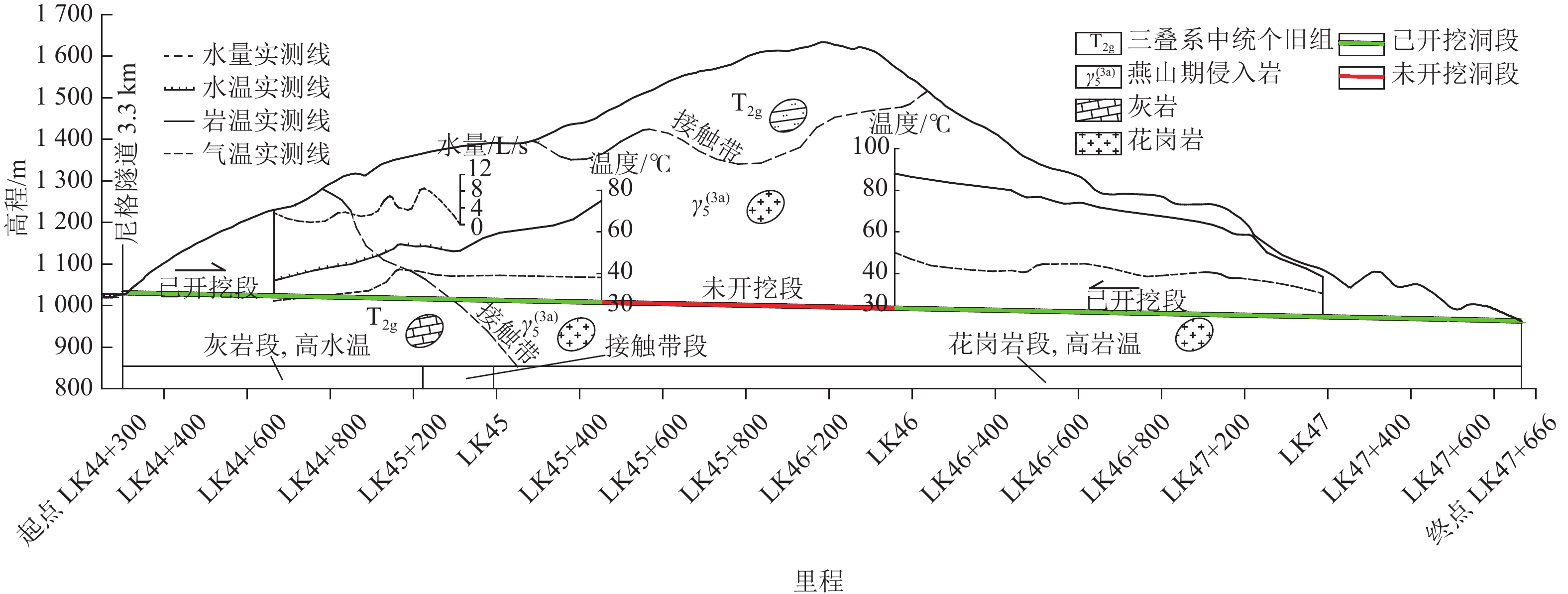
 下载:
下载:
